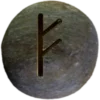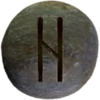Last Updated on December 20, 2024
Table of Contents


Saehrímnir (pronounced SIGH-hrim-neer, Old Norse: Sæhrímnir) is a mystical creature central to Norse mythology ![]() . His name translates to “sooty sea-beast,” suggesting his connection to cooking and the sea. Saehrímnir appears in the Grímnismál of the Poetic Edda and the Gylfaginning of the Prose Edda. In these texts, he is the boar whose flesh feeds the warriors in Valhalla.
. His name translates to “sooty sea-beast,” suggesting his connection to cooking and the sea. Saehrímnir appears in the Grímnismál of the Poetic Edda and the Gylfaginning of the Prose Edda. In these texts, he is the boar whose flesh feeds the warriors in Valhalla.
Every evening, Saehrímnir is slaughtered and cooked in the magical cauldron, Eldhrímnir (pronounced ELD-hrim-neer). Despite being consumed, he is miraculously restored to life each day. This cycle ensures the Einherjar—fallen warriors chosen by Odin—always have sustenance.
The legendary cook, Andhrímnir (pronounced AND-hrim-neer), oversees Saehrímnir’s preparation. His culinary skill guarantees an eternal feast for the warriors preparing for Ragnarök. Saehrímnir’s ability to regenerate symbolizes abundance, resilience, and the cyclical nature of existence.
The texts do not detail Saehrímnir’s appearance. Some interpret him as a wild boar, while others view him as a mythological creature beyond mortal comprehension. His role in Norse cosmology emphasizes the divine provision and sustenance granted to Odin’s chosen warriors.
Saehrímnir embodies more than food; he represents renewal and preparation for ultimate battles. His story reflects the Norse focus on readiness and the eternal bond between life and death.
Two Elder Futhark Runes Associated with Saehrímnir
The Ūruz (ᚢ, pronounced OO-rooz) rune symbolizes strength and endurance. Saehrímnir’s daily regeneration embodies these qualities. Like the rune, he is a source of resilience and vitality.
The Fehu (ᚠ, pronounced FAY-hoo) rune signifies wealth and abundance. Saehrímnir’s unending sustenance aligns with this rune’s meaning, representing prosperity and renewal. Together, these runes capture Saehrímnir’s essence as a creature of eternal provision. ![]()
Importance of Saehrímnir to Asatruar
To Asatruar, Saehrímnir represents renewal, abundance, and divine sustenance. His story inspires preparation for life’s challenges and reverence for cycles of existence. Saehrímnir also reminds followers of the sacred balance between life and death, celebrated in rituals and storytelling. He symbolizes communal strength and shared purpose, reflecting the unity of kin and community.

